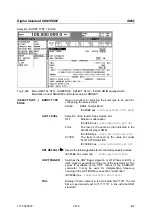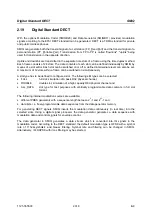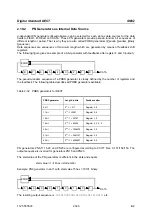
Digital Standard DECT
SMIQ
1125.5555.03
E-9
2.318
2.19
Digital Standard DECT
With the options Modulation Coder (SMIQB20) and Data Generator (SMIQB11) provided, modulation
signals according to the ETSI DECT standard can be generated. DECT is a TDMA standard for private
and public cordless phones.
SMIQ can generate both the transmit signal of a cell station (FP, Fixed Part) and the transmit signal of a
personal station (PP, Portable Part). Transmission from FP to PP is called "downlink", "uplink" being
used for transmission in the opposite direction.
Uplink and downlink are transmitted in the separate time slots of a frame using the time duplex method.
Each frame consists of 24 slots. The data contents of each slot can be defined individually by SMIQ by
means of a slot editor. Each slot can be switched on or off. A defined intermediate level can also be set.
A maximum of 12 slots within a frame can be switched on simultaneously.
A slot type has to be defined to configure a slot. The following slot types can be selected:
•
FULL
full slot; simulation of a basic R32 physical channel,
•
DOUBLE
double slot, simulation of a high capacity R80 physical channel and
•
ALL_DATA
slot type for test purposes with arbitrarily programmable data contents in full slot
format.
The following internal modulation sources are available:
•
different PRBS generators with a sequence length between 2
9
-1 and 2
23
-1 and
•
data lists, i.e. freely programmable data sequences from the data generator memory.
For generating DECT signals, SMIQ inserts the modulation data continuously (in real time) into the
selected slots. Using a digital signal processor the data generator generates a data sequence with
modulation data and control signals for envelope control.
The data generator in SMIQ generates a data stream which is converted into IQ signals in the
modulation coder. According to the DECT standard, the default modulation type is GFSK with a symbol
rate of 1152 ksymbols/s and Gauss filtering. Symbol rate and filtering can be changed in SMIQ.
Alternatively,
π
/4 DQPSK with
√
cos filtering may be selected.






























